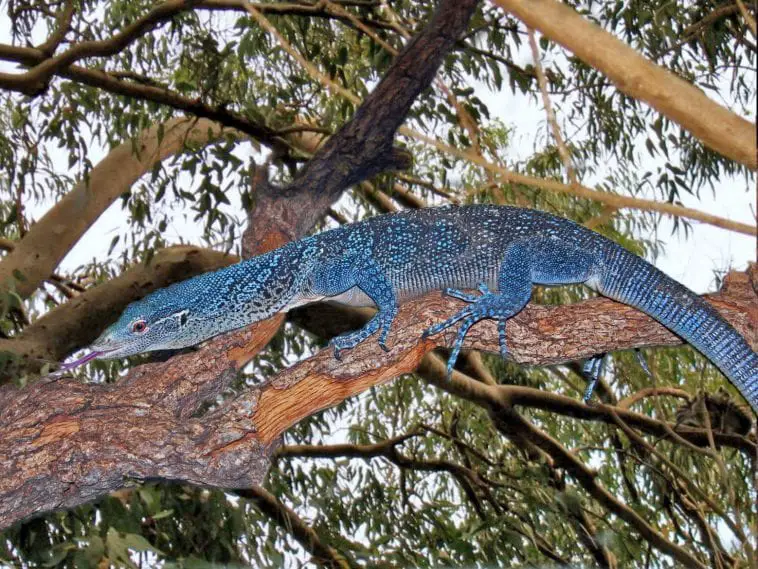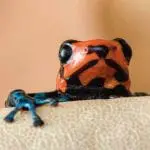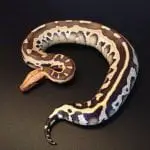Scientific Facts
| Common Name | Blue-Spotted Monitor, Blue Tree Monitor |
| Scientific Name | Varanus macraei |
| Captive Lifespan | 10 – 20 Years |
| Size | 3 – 3.6 ft. |
| Mass | 150 – 250 grams |
| Habitat | Rainforest |
| Country of Origin | Batanta Island, Indonesia |
Physical Description
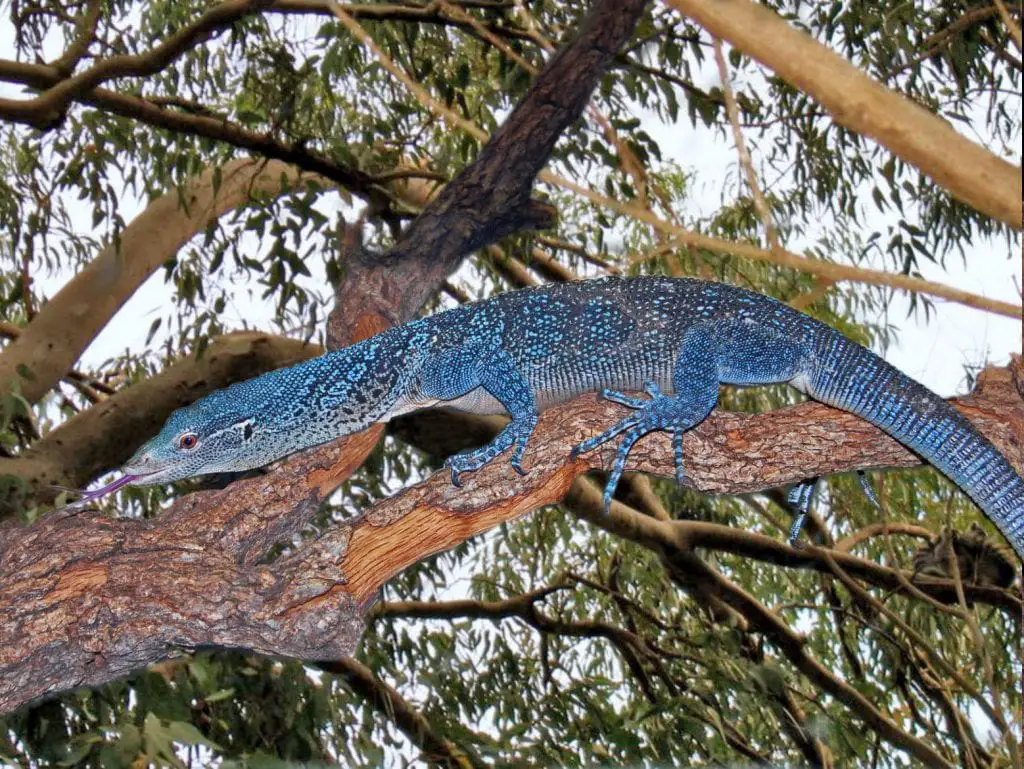
With a tail capable of tightly grasping branches, and making up for approximately 2/3 of the total length of the slender, elongated body, Varanus macraei, better known as blue-spotted monitor, is a lizard-like no other.
The limbs of blue tree monitors are just as slender as the overall shape of the body. The limbs are long and widely separated. Each limb ends with a total of five long and thin digits.
The neck in this species tends to appear as if quite long. However, the neck’s length is not any longer than the skull’s length. The visual delusion of the neck’s impressive length is due to the unique body dimensions of these lizards.
Blue tree monitors’ keeled caudal scales are arranged in well-defined rings, while the scales at the neck (aka the nuchal scales) are very smooth.
Along the dorsal and lateral surfaces, the body of this unique lizard is somewhat flattened. The body coloration is typically black, although in some cases, the coloration can be exceptionally dark gray. One of the most distinctive traits of this lizard’s body is the eye-like spots colored in whimsical turquoise-cobalt-blue.
Around the length of the tail, blue-gray bands can be easily spotted. The coloration of the belly of the blue tree monitor varies from powder pale blue to grayish, with smears of dark-gray.
Male blue tree monitors are larger than females. Males can be distinguished from the females by the hemipenal bulges (the internal male sex organs), posterior and lateral in position to the cloaca. Also, the temporal region is comparatively wider in males.
Adult male blue tree monitors may reach 3½ feet in length (including the length of the tail). Adult females usually grow 4 inches shorter than the males.
Types
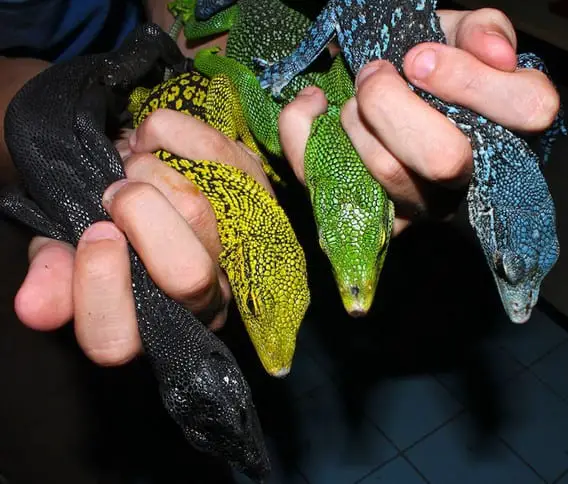
Up-to-date Varanus macraei is the largest known species of the Varanus prasinus species group. V. prasinus is a group of related species. Interestingly, the species forming this group are known to share closer similarities with each other than other members of the Varanus genus.
It was only about two decades ago when the tree monitor group used to be compromised of only five species in total, namely V.beccarii, V. keithhornei, V. prasinus, V. telenesetes, and V. bogerti. The number of species in the tree monitor group expanded in the early years of the 21st century, when V. macraei, V. reisingeri, and V. boehmei were discovered and named.
These species share considerable similarities, and because of this, making a differentiation between them was a quite complex task, even for the most reputable experts in the niche. For instance, some of the species in the V.prasinus group were found to have only very little yellow pigmentation, thus, appearing pale blue in color. Another example is V. reisingeri, significantly resembling V. prasinus, except for lacking blue pigmentation.
As of now, there are still very few reports relating to the origin of any of the tree monitors. However, thanks to captive breeding practices, nowadays, there is considerable knowledge available when it comes to V. prasinus (the green tree monitor), and V. becarii (the black tree monitor).
Ultimately, thanks to dedicated herpetoculturists, as well as several zoos across the globe, V. macraei (the blue tree monitor) has been also successfully kept, bred, and studied in recent years.
Of all tree monitors, the blue-spotted monitor is believed to have the smallest distribution, as blue tree monitors are only found to inhabit a rather restricted region of the Batanta Island, and in particular, they are known to occupy areas northwest of the Vogelkop Peninsula.
Habitat & Lifespan
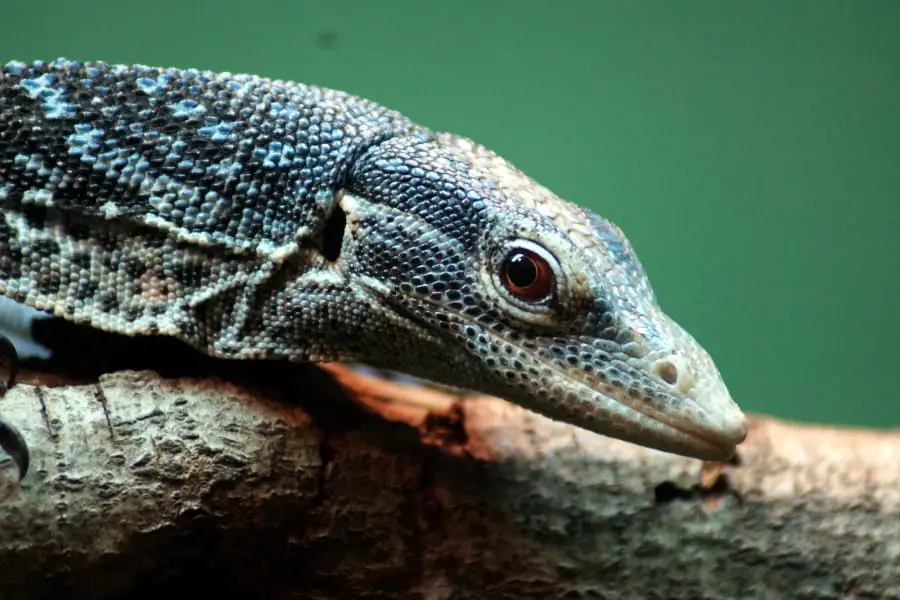
The natural habitat of blue-spotted monitors in the wild consists of tropical rainforests. The daytime temperatures in the rainforests inhabited by blue tree monitors are consistent within the 83 – 100 degrees Fahrenheit range all year round, and only drop 2 – 4 degrees at night. The humidity in the native habitat of these creatures reaches up to 100% in the wet season and about 65% during the dry season.
In the wild, blue tree monitors typically live for about 10 years. However, in captivity, these amazing reptiles usually live for more than 10 years.
Behavior
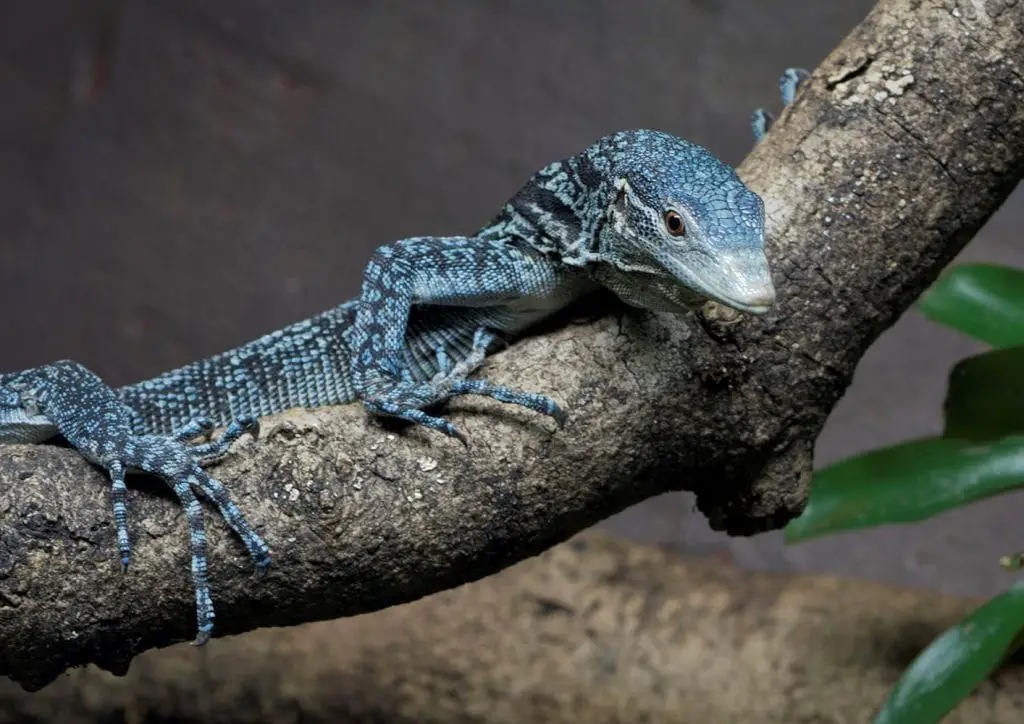
Blue tree monitors’ behavior and natural ecology continue to be embraced in mystery up-to-date, as relatively little is known about the habits of these extraordinary animals.
Based on the available research, experts assume that blue-spotted monitors are active during the day, and almost completely arboreal, meaning that they spend most of their time up in the branches of the trees. Thanks to their sharp claws, these reptiles can have a secure hold on just about any rough surface.
Also, blue tree monitors climb up and down with ease.
Similarly to the way chameleons use their tails, blue-spotted monitors utilize their tails pretty much like grasping tools. However, blue-spotted monitors can do another amazing “trick” with their tails, and this differentiates them from chameleons. Blue tree monitors can coil their tails horizontally to their bodies. If needed, monitors can then uncoil their tails quite rapidly, and this serves as a form of a defensive, natural whip.
Blue tree monitors are not aggressive animals. Similarly to most other monitor lizards, the blue-spotted monitor avoids potential predators rather than switching into attack mode. Being nervous by nature, blue tree monitors will quickly flee up in the trees whenever a possible threat is detected.
Similarly to squirrels, blue-spotted monitors will keep the tree trunk as a form of a shield between them and any potential threat.
Caging
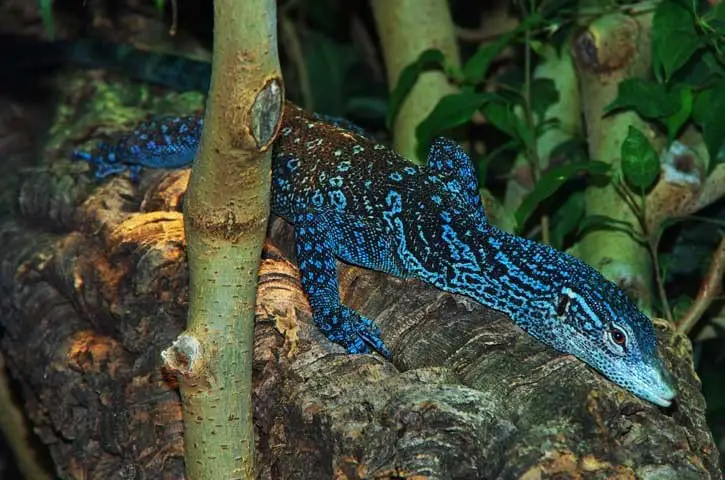
- Providing an adequately large terrarium is a must. The minimum recommended dimensions for housing a captive blue tree monitor are 3 feet tall and 6 feet to each side. For housing young blue tree monitors up to 6 months of age, an 18’’x18’’x36’’’ terrarium should be sufficient.
- Keepers are highly recommended to use a suitable screen for the purpose of limiting the blue tree monitor’s vision outside the enclosure. If not limited, this can potentially make the reptile more nervous and uncomfortable in general, especially as these creatures tend to feel easily disturbed by any objects moving on the outside. Not the least, Blue tree monitors simply do not understand glass, so they will most likely end up banging their noses on the glass surface, and hurting themselves repeatedly until they finally learn the enclosure’s boundaries.
- For limiting the blue-spotted monitor’s vision outside the enclosure, caregivers can make use of a one-way glass window. Alternatively, part of or all of the windows can be upgraded with smoky-black or plastic Plexiglass.
- In a pinch, caregivers can simply cover the windows with fabrics, towels, or cardboard. However, this should only be considered as a last resort, since doing so will not allow the keepers to see into the terrarium in order to admire the sublime beauty and curious habits of their captive blue-spotted monitor.
- Blue-spotted monitors need hiding spots to feel safe, comfortable, and secure. Providing a single hiding spot is not sufficient. Several hiding spots will work great.
- Tree trunks can make wonderful hiding spots. Do make sure that any tree trunk you are about to utilize is wide and tall enough to allow the lizard to turn around effortlessly once inside, as well as to be able to hide completely whenever desired.
- Apart from ensuring the comfort and well-being of the reptile, making use of several hide boxes is also excellent when it comes to possible breeding practices, as hide boxes can be used as suitable nest sites.
- Blue-spotted monitors will feel the coziest when having an enclosure that perfectly simulates the abundant, rather complex, twisted branching of treetops in these reptile’s natural habitat. Make sure the enclosure is equipped with a minimum of one tall and broad tree trunk or other forms of a suitable climbing post, accompanied by several horizontal branches.
- To keep your blue monitor pet healthy, you need to prevent the growth of fungi and mold. Therefore, proper ventilation is a must, and caregivers need to plan the enclosure’s design accordingly in advance.
- It is best to position ventilation holes on one side of the terrarium, close to the upper section of a side wall, and close to the floor of the other side of the terrarium. This type of ventilation setup will ensure that the air will cycle through the enclosure naturally, fully, and freely, without causing unwanted drafts and/or lowering the temperatures below the optimal rates.
- For ensuring proper ventilation that will remove stagnant air, the terrarium’s top must be solid enough. Lighting apertures positioned on the very top of the enclosure should be considered, too.
Substrate
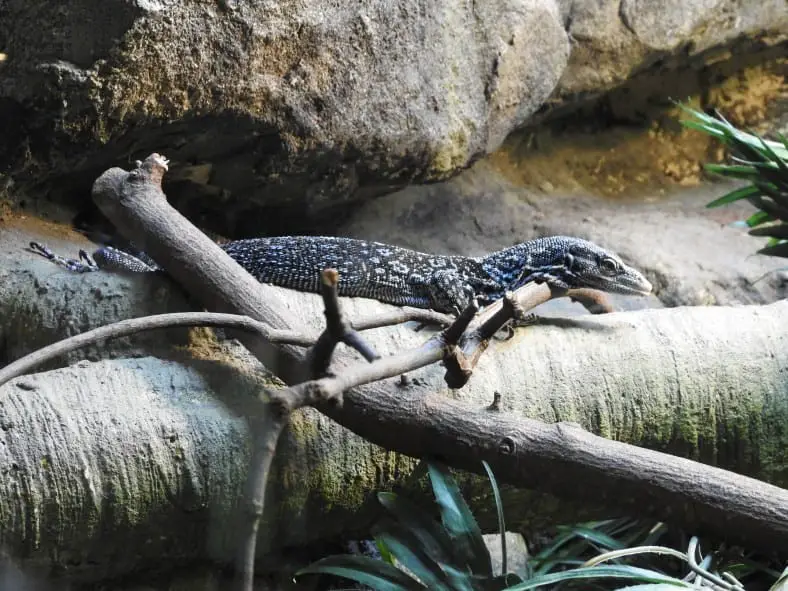
- Clean, organic soil makes an ideal substrate for captive Blue Tree Monitors. At any cost, make sure the soil has not been treated with any chemicals, such as fertilizers or pesticides.
- Also, make sure to sterilize soil if obtaining it from the outside, instead of opting for commercial-grade, high-quality soil. Soil obtained from the outside may be infected with unwanted bacteria or parasites.
- Soil and sand mixture can also work great. Nonetheless, clean bark chips can be successfully utilized.
- The substrate has to be about 1 foot in depth.
- For keepers who intend to breed their blue tree monitors, make sure to provide a large box of 12 inches deep soil.
Temperature, Lighting & Humidity
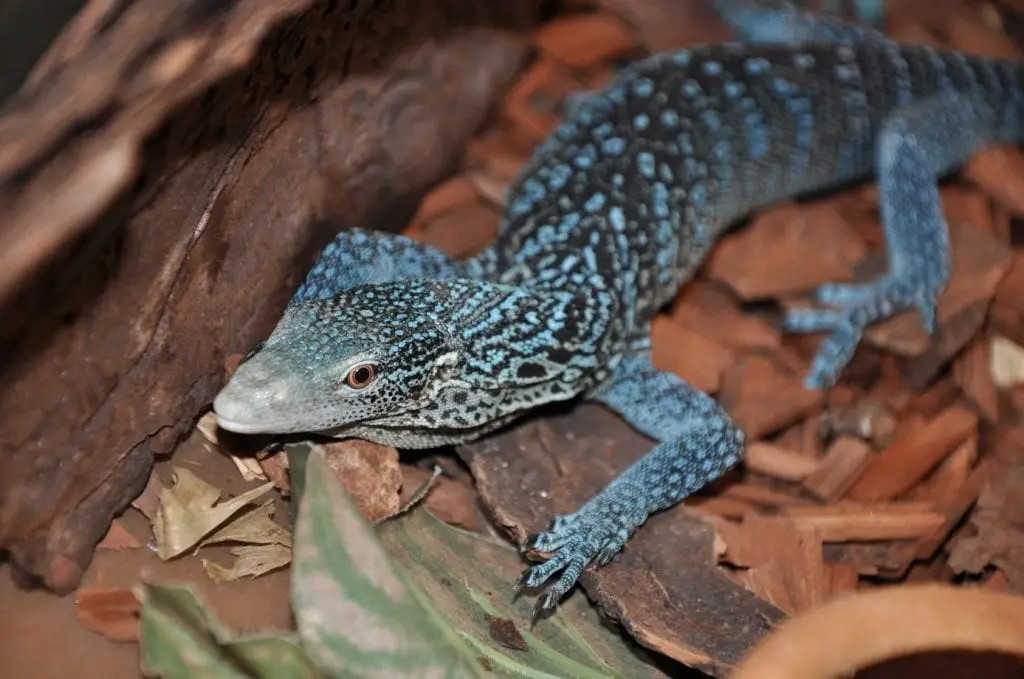
- As Blue-Spotted Monitors come from a tropical climate, these lizards require a cooler section, as well as a basking area, for the purpose of regulating body temperature properly. Therefore, heat and lighting elements should be positioned on one side of the enclosure.
- Keep the ambient air temperature between 83 to 100 degrees Fahrenheit.
- The isolated basking site should be located close to the very top of the vivarium to mimic perfectly the natural conditions in the wild where these creatures thrive. In the basking area, temperatures must be maintained within the 104 – 108 degrees Fahrenheit range.
- When designing the basking area, do not use heat rocks. Then again, the keeper’s goal is to simulate the optimal natural conditions for these reptiles, and in the wild, blue-spotted monitors are used to receiving heat from above and not from below.
- Captive blue tree monitors are deprived of sufficient, consistent access to sunlight. Because of this, keepers need to utilize a suitable UVB light source, such as a special fluorescent bulb.
- Mercury vapor light bulbs typically make the best choice for a blue tree monitor’s enclosure, as these bulbs provide both UVB and heat altogether. Alternatively, separate UVB bulbs and heat bulbs can be utilized accordingly. 100watt light bulbs are highly recommended.
- In the basking site, blue-spotted monitors will be able to receive direct light provided by a heat lamp. However, the rest of the lighting must be indirect, meaning that light should not fall all the way down to the floor. For this purpose, caregivers simply need to provide suitable cover, as it is the cover that will simulate the natural indirect light effect achieved by leaves and branches in the wild.
- Keep the lights ON for at least 10 and up to 13 hours per day.
- Humidity should be best maintained within the 80% range. By misting the terrarium several times a day, keepers can provide enough moisture for the reptile to thrive.
- For those who dislike the idea of having to utilize hand misters, automatic misters can make a wonderful option. Reptile fountains can also work excellent, as they provide bubbling water that raises humidity levels.
Diet
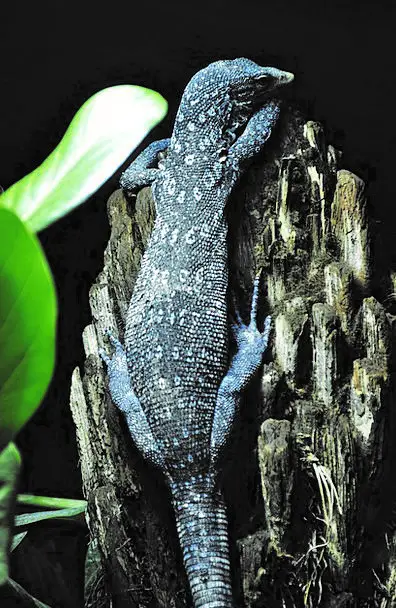
Although it may seem hard to believe, the natural diet of blue tree monitors remains unknown up-to-date. All of what experts know about the blue-spotted monitors’ diet in the wild is based on existing reports about the diet of the other tree monitor species, which is presumably consistent with that of V. macraei species.
Blue monitors’ diet is believed to be made up of stick insects, which are considered the primary source of food for these reptiles, followed by crickets, grasshoppers, and katydids. Moths, smaller lizards, beetles, and small eggs are also part of the menu of blue monitors. Occasionally, these animals are also said to take berries.
In captivity, blue-spotted monitors are predominantly fed with crickets and worms.
Eating Habits
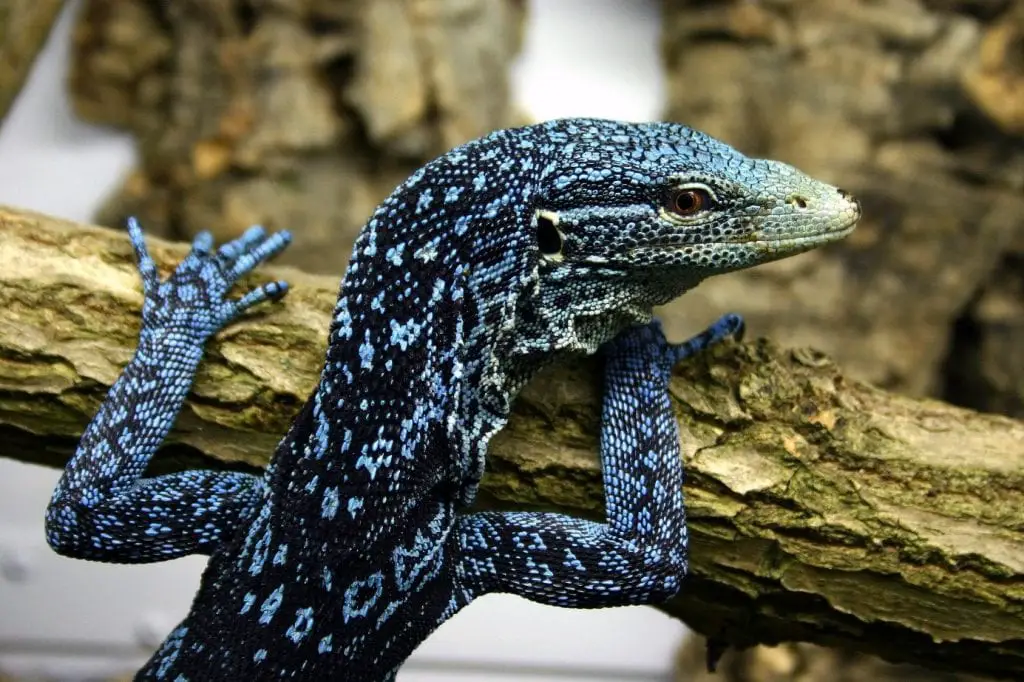
Unless a blue tree monitor’s caregiver happens to live quite close to the natural habitat of these amazing reptiles, it is highly unlikely that he/she would be capable of providing the same dietary variety consumed by these lizards in the wild, where the species-rich tropical rainforests boast of a wide variety of delicacies.
However, crickets make an excellent, nutrient-rich food item for captive blue-spotted monitors, as crickets are a natural part of these lizards’ diet in the wild.
If available, grasshoppers and roaches, among other large insects, are also a wonderful choice for satisfying the eating habits of blue monitor kept as pets.
Before offering just about any type of insects to a blue tree monitor, caregivers need to make sure that the insects have been fed with green, fresh vegetable matter, like spinach, celery leaves, and lettuce, to name a few.
Also, insect food, as well as the insects themselves prior to being fed to the lizard, need to be dusted with Calcium and Phosphorus supplement.
Blue-spotted monitors are known to be very active lizards, and so their feeding routine should correspond to their active eating habits. Blue monitors should be provided with live food items daily. Any food items that have not been consumed within the course of one day are to be caught and eaten by the lizard the next day.
It is a good idea to offer freshly killed young mice biweekly. Mice are not a typical part of these lizards’ natural diet in the wild. However, mice are very nutrient-dense, full of vitamins and minerals, and especially rich in Calcium, which is such a crucially essential element for the well-being of captive reptiles.
Sleeping Habits
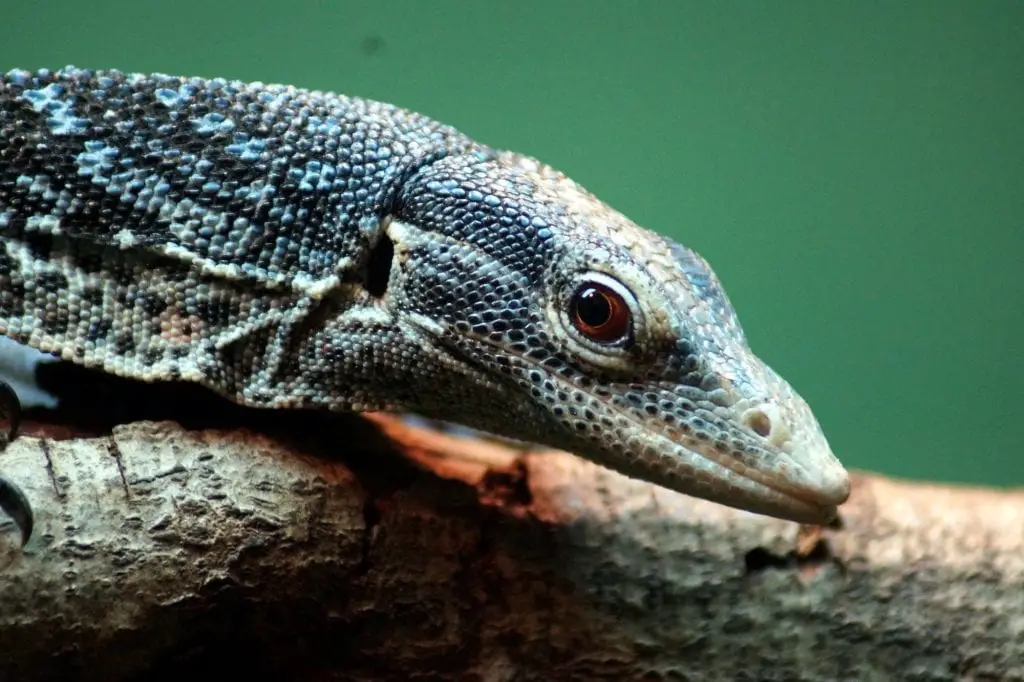
Even though sufficient data regarding the sleeping habits of Blue-spotted monitors is still lacking, these creatures are widely believed to be diurnal, meaning that they are most active during the day. Blue monitors do not hibernate.
Water
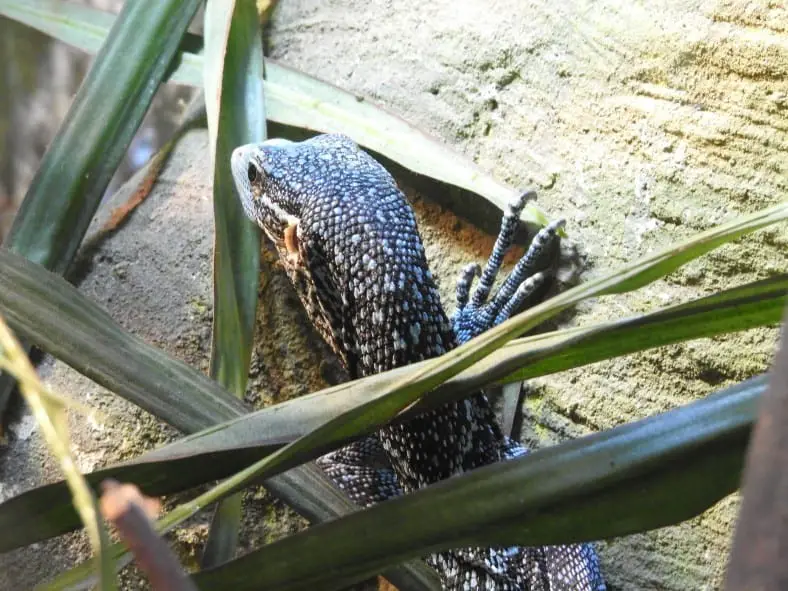
Caregivers must ensure that a large container of fresh, clean drinking water is available for their blue monitor pet at all times.
Blue-spotted monitors will only drink from standing water, so any running water bodies will not do the job for keeping these reptiles well-hydrated.
Also, mind that blue monitors will frequently soak in water, with the frequency being the highest prior to shedding. Therefore, the size of the water bowl should be considered carefully as to fit the size of the lizard, allowing the animal to comfortably soak in its entire body whenever needed.
Apart from satisfying the water requirements of these reptiles, a large container of water will also help to maintain the much-needed high humidity within the enclosure.
For simulating the natural environment of your blue monitor pet better, you can intensely spray water every afternoon for about three months, thus, mimicking the wet season. Then, you need to stop spraying for another three months. Between the simulated wet and dry seasons, caregivers should only perform 1 -2 sprayings weekly.
Development and Reproduction
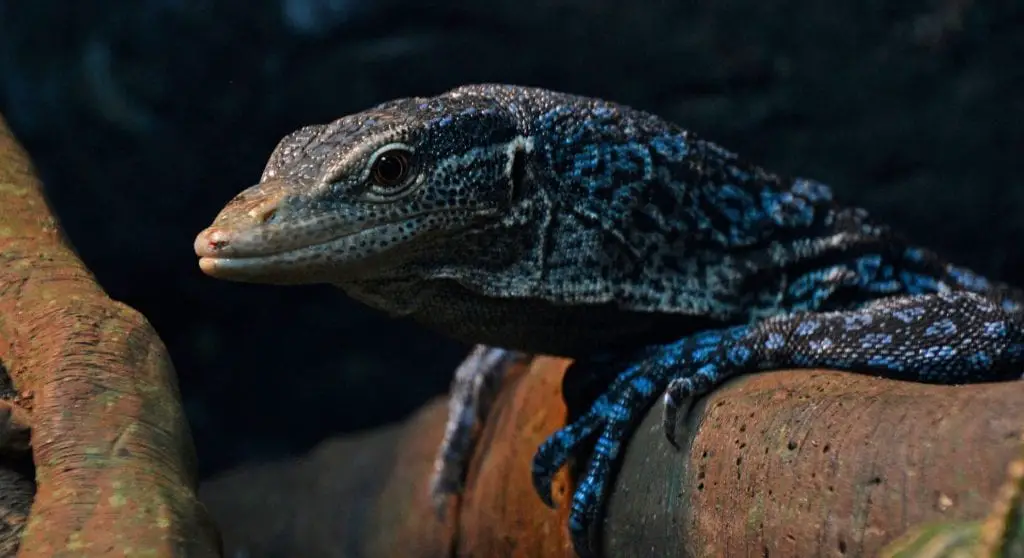
Too little is known about the reproduction and development of blue monitors in the wild, at least as of now. However, based on observations from captive breeding settings, experts have come to believe that courtship is initiated by the female.
Females receptive to mating are reported to approach the male. Afterwards, the couple is to spend time basking together, sharing the same perch for several days.
Within the next few days after the shared basking “ritual,” mating is to typically occur.
Captive female blue monitors have been observed to create their laying nests out of dirt, leaf matter, coconut fiber, and moss. The eggs are laid approximately one month after mating, carefully buried in the prepared nest.
Apart from creating a nest to lay the eggs, and respectively, to lay the eggs, females have no further parental responsibility for their young, and neither do males.
Females usually lay between 1 and up to 5 clutches of eggs annually. Experts suggest that the number of clutches laid per year greatly depends on the food intake of these reptiles throughout the year, with varied, abundant, nutritious meals possibly contributing to more clutches per year.
How to Breed
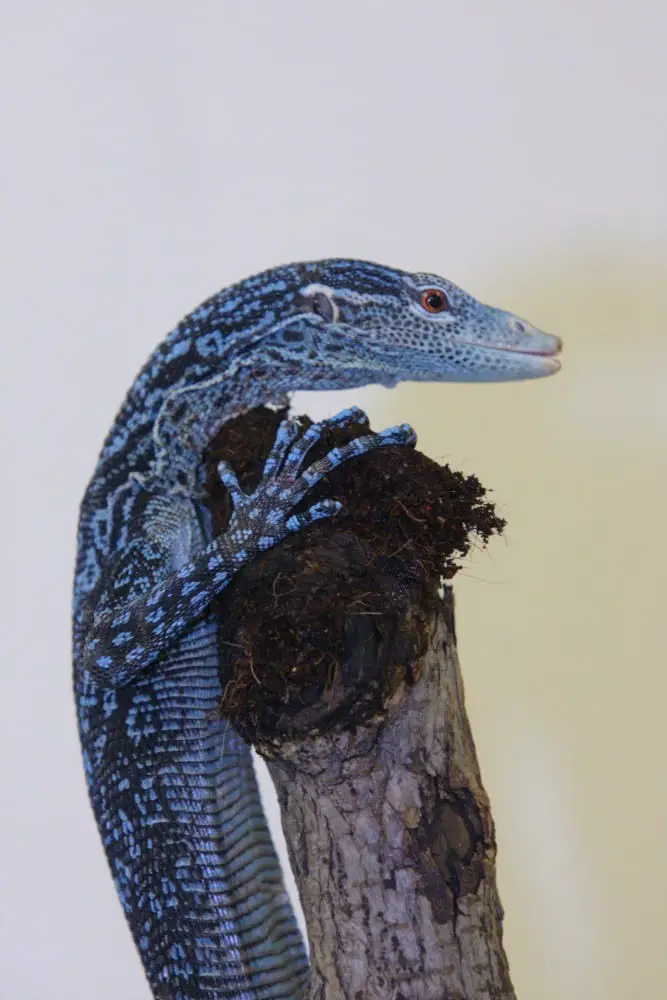
Although still limited to being a rare triumph that has been successfully accomplished by only several highly skilled and dedicated herpetoculturists across the globe, getting captive blue monitors to reproduce may be achieved by caregivers who are truly consistent about learning more about these amazing reptiles.
It is believed that the best way to increase the chances of mating captive blue-spotted monitors is to separate the female from the male/males up until breeding is intended to take place. As soon as the keeper is ready to breed these reptiles, the female should be introduced to the male’s enclosure, and not vice versa.
Provided the female is mating-receptive; she should be the one to approach the male. Afterwards, the pair of blue monitors is to typically spend some “quality time together” by basking on the same perch for days, but usually not longer than a week. In some cases, though, mating can take place immediately after the male and the female have been introduced.
If mating is to be fortunate, the female will become more active during gestation, and she will also require more food. Regardless of what type of food the gestating females are provided with, insects should also make a daily addition to their feeding routine.
Gestating female blue-spotted monitors will also spend quite some time in the basking site for the purpose of elevating their body temperature.
Since all tree monitors. V. macraei species included, are characterized with slender bodies, it may be hard, if possible at all, to tell that a female is gravid up until the very moment of egg-laying.
In any case, breeders should make sure to equip the enclosure with egg deposition-friendly hide boxes.
It is best that the boxes are to be attached firmly onto one of the terrarium’s walls. Also, the boxes must be easy to access by the female blue monitor from the inside, and further equipped with a second door, allowing the keeper to ease access to the hide box contents.
On the inside, the nesting hide box should be layered with potting soil, vermiculite, leaf matter, as well as sphagnum moss. Loamy sand can make a good alternative to moss.
It is essential that the materials within the nesting hide box are to be able to retain moisture. However, the medium should be kept only slightly moist at all times and not soaking wet.
If the females are not to seek out the nest boxes to lay their eggs within three to five weeks after mating, then mating is most probably unsuccessful.
Captive blue monitors usually deposit anything from three to six eggs.
As soon as the keeper is to spot the eggs within the nesting hide box, he/she needs to carefully remove them. Next, the eggs must be incubated, by being placed in a suitable enclosure, utilizing the same medium as the one within the nesting hide boxes.
Proper incubation will take place in temperatures kept within the 84 – 86 degrees Fahrenheit range. Hatchlings should appear after 150 days.
Handling
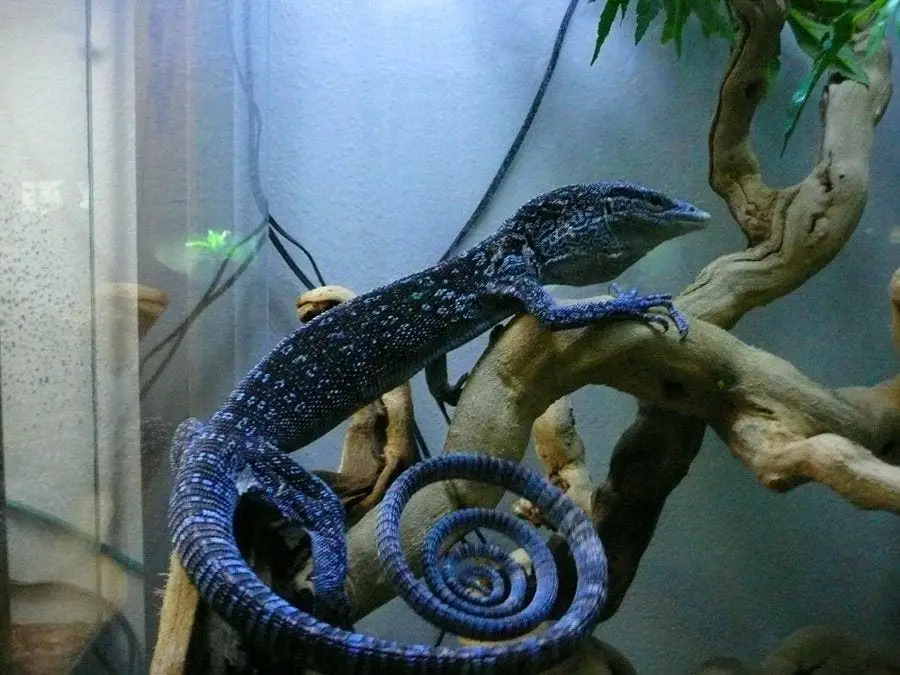
As a rule of thumb, tree monitors are not typically very fond of handling, and especially when it comes to a lot of handling.
However, with patience and some proper training, these incredible creatures can get well-used to handling over time, and they are fully capable of enjoying being handled, as long as this only happens for short periods of time.
Even when a blue-spotted monitor has overcome its initial nervousness and has started to seek interaction with his/her owner, it is always best to wear long sleeves, as well as protective gloves if necessary, since even calmed down specimen are still armed with sharp claws that can scratch and break human skin.
How to Treat and Prevent Possible Health Issues
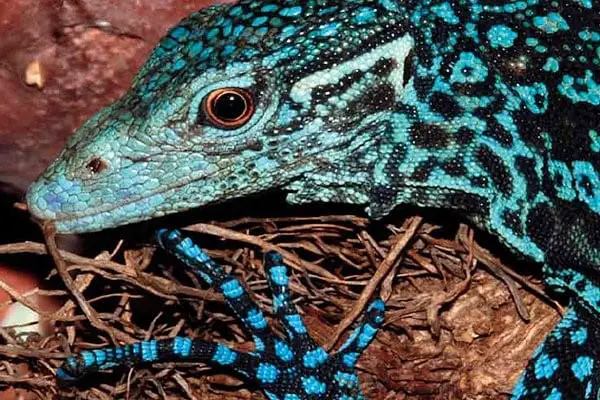
- It is a must that an appropriately-sized water dish, filled with clean, fresh drinking water is provided at all times. Since blue tree monitors will also use their water bowl as a bathroom spot, it is crucial to change the water daily, as to prevent the buildup of bacteria. Not the least, the bowl should be thoroughly scrubbed at least once weekly.
- All tree monitors, including blue-spotted monitors, are very susceptible to illness caused by temperatures and/or humidity dropping lower than the optimal rates recommended for taking care of captive blue monitors, based on the reptile’s natural environmental conditions in the wild. Keepers need to use high-quality gauges to monitor both temperature and humidity levels. As long as monitoring is done with care and dedication on a daily basis, these beautiful creatures can keep you company, thriving in perfect health, for more than 10 years.
- Fitting the terrarium with good-quality, full-spectrum light needed to provide the desired levels of ultraviolet exposure for facilitating proper, full physiological use of calcium and Vitamin D3, is a must to ensure the health and well-being of blue monitors for years to come.
Possible Dangers to Humans
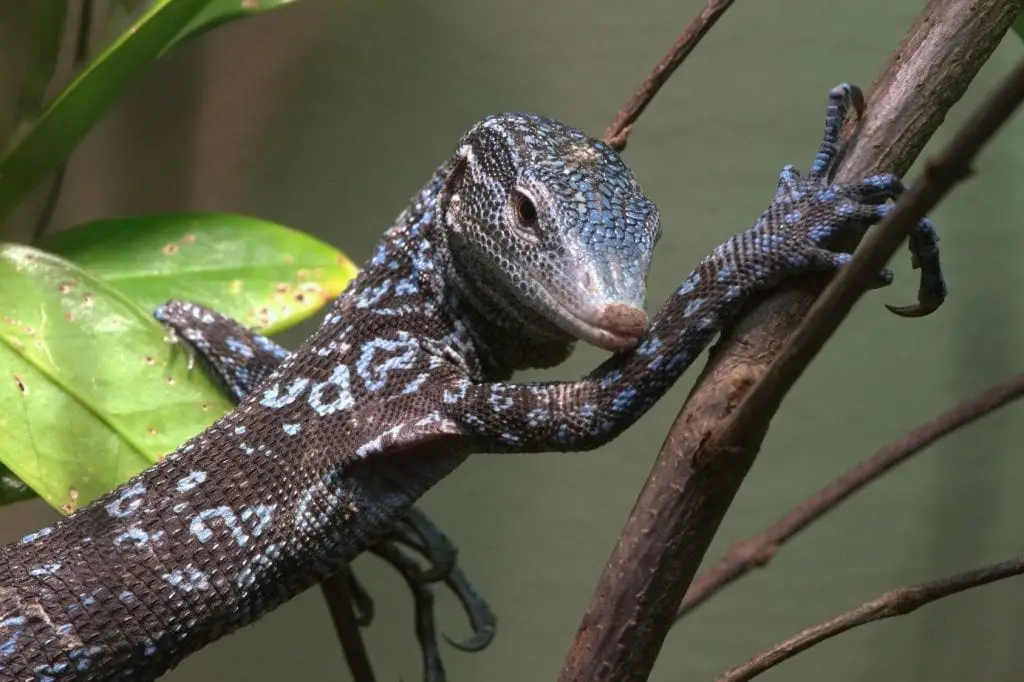
It is best that newly acquired blue-spotted monitors are to be kept quarantined until a full examination is provided by a qualified veterinarian, so that any signs of possible ill health can be thoroughly investigated, caught, and respectively treated, as early as possible, without causing any harm to the caregivers and their families.
For those who acquire a blue monitor from licensed retailers/breeders, the quarantined period can be avoided. However, if children, elderly people, or people with weak immune system or autoimmune disease are also in the house, it is best to stick with the recommended quarantined period, since these groups of people are more vulnerable to any unwanted disease carried by wild-caught blue monitors, such as Salmonella and parasites, among others.
A professional veterinary checkup can save keepers a lot of trouble. Once caregivers are sure that the reptile is healthy, they merely need to provide the right conditions to keep the animal in great shape.
Whenever handling a blue monitor, even when it comes to handling a blue monitor that is already well-used to human interaction with his/her owner, do be careful about eventually getting hurt by the sharp claws, especially since these reptiles are easily startled, causing them to tighten the grip and/or try to swiftly crawl up the owner’s hand, as if climbing a branch.
Availability: How to Get a Blue-Spotted Monitor?
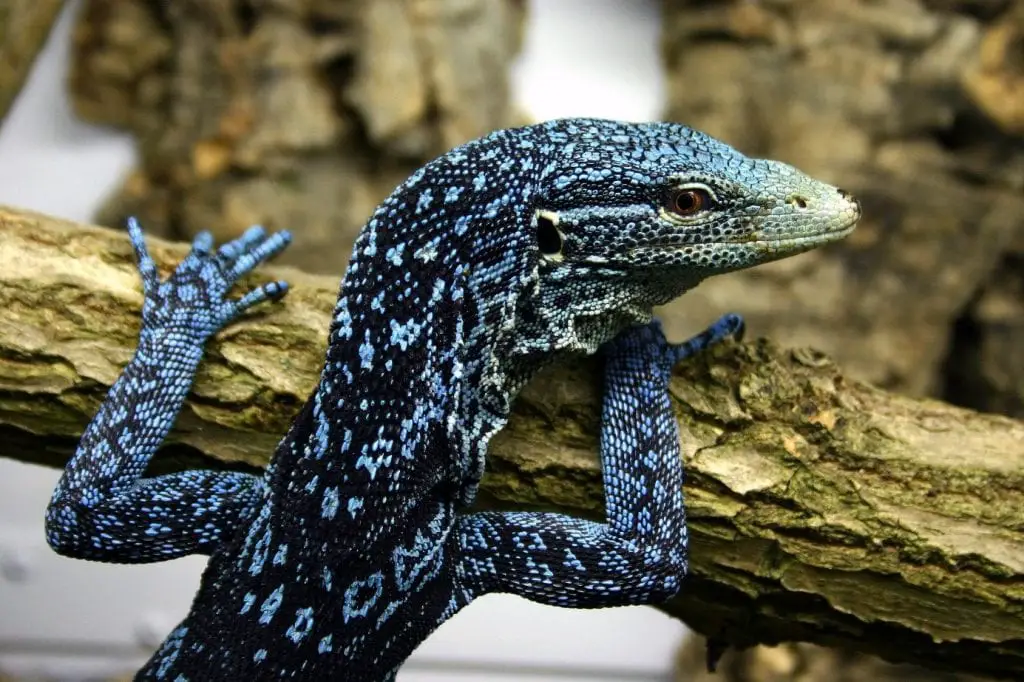
At present, there is still only a limited number of captive-bred blue-spotted monitors. Regardless, it is always best to only obtain a blue monitor from reputable breeders/retailers, and not from suspicious retailers offering wild-caught monitors.
Note that based on the Convention on International Trade of Endangered Species, wild blue monitors do have some protection from being collected for the pet trade, as well as from being hunted, so buying wild-caught monitors might be part of illegal pet trade chains.
Wild-caught blue tree monitors may host a wide range of unwanted diseases, some of which may be harmful to humans, while others may lead to the sudden death of these extraordinary reptiles. Also, a wild-caught specimen is much more difficult to tame. With this in mind, purchasing a captive-bred blue-spotted monitor is always the wisest option.
Fun Facts
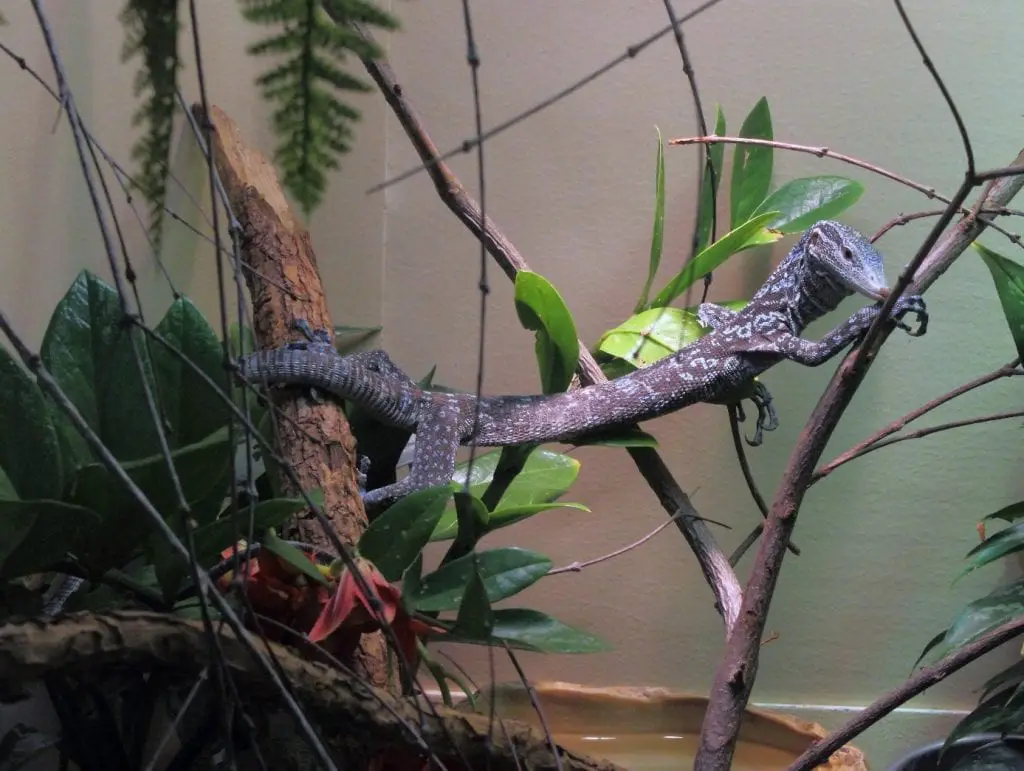
- The blue tree monitor was not discovered until 2001.
- Because of its blue phase, the green tree monitor may seem similar to the blue tree monitor at a quick glance, even though the coloration of blue tree monitors is actually significantly and distinctly different.
- Exact census numbers about the wild population of blue-spotted monitors do not exist as of now, majorly because of these amazing reptiles being discovered fairly recently.
- The very name of the “Varanus” genus originates from the Arabic word “waral,” which translates into “monitor.” Tree monitors often tend to stand on their two legs, making them seem as if to monitor their surroundings, and this is exactly what led to granting these reptiles the original Arabic name “waral.”
- According to Yale University ornithologist Rick Prum, blue is one of the fascinating colors in nature as most animals are not capable of making it with pigments. Of all the existing colors in the world, the color blue is the most unlikely to occur on the fur, scales, feathers, skin, and/or exoskeletons of living creatures, making the blue-spotted monitor a true natural phenomenon.
How to Take Care of a Blue Tree Monitor
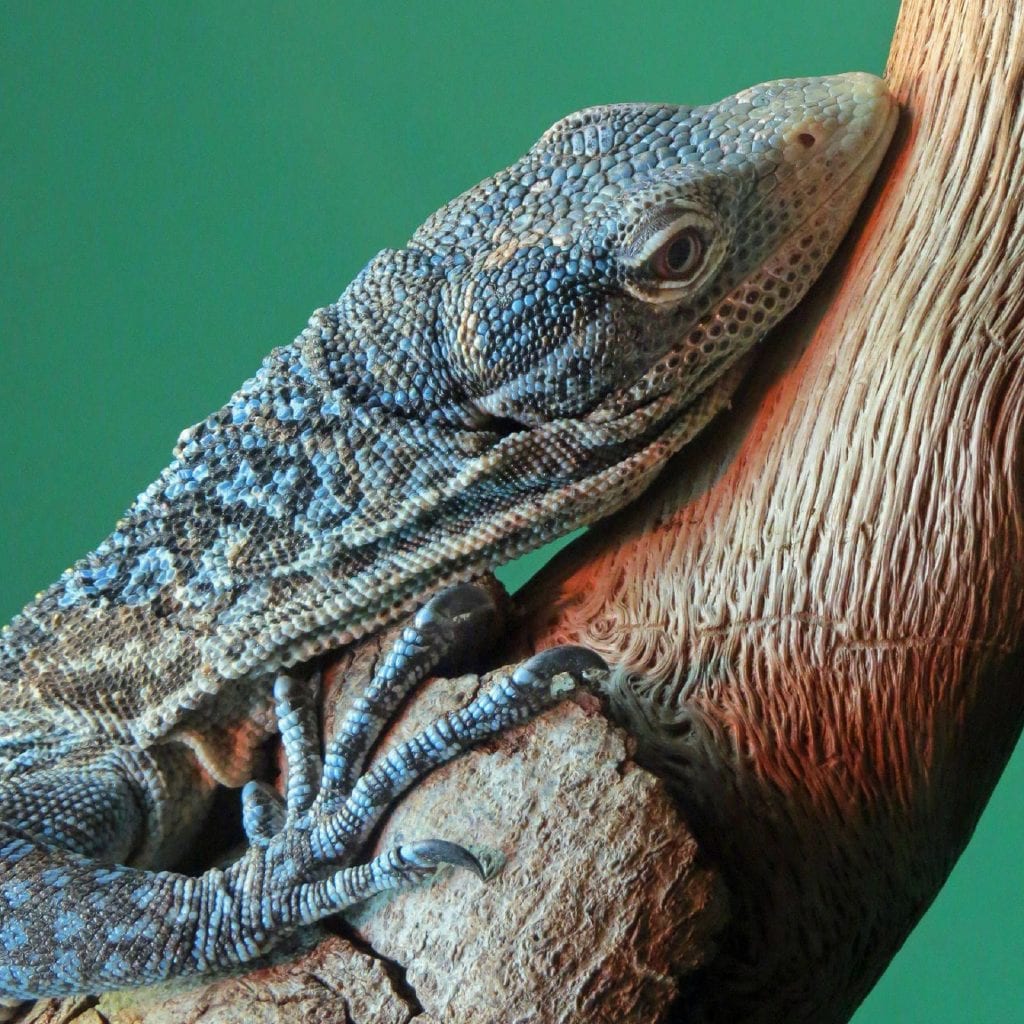
- Blue-spotted monitors are extremely nervous, quite wary lizards. It is often the case that newly acquired blue monitors are prone to run into the walls, as well as to become hyperactive when given even the least disturbance. It is the caregiver’s responsibility to protect their lizard pet from damaging itself by tinting the enclosure’s windows, and nonetheless, by respecting the reptile’s privacy until the animal feels more comfortable and less nervous over time.
- At the very beginning of taking care of a blue-spotted monitor, the keeper should avoid picking up and/or touching the animal. Instead, the reptile should be given the opportunity to get used to its new surroundings, as well as to the caregiver. Let the blue monitor get used to your voice and your movements without making the reptile think of you as a possible threat.
- Suitable activities that can help a blue-spotted monitor get better used to his/her caregiver at the start include changing the water, cleaning the enclosure, allowing the reptile watch you place food within the terrarium, moving around the terrarium in a nonthreatening manner, such as working on your laptop, reading, or watching a movie.
- Over time, being the curious creature that it is, a blue tree monitor will certainly start to stay out much more often, rather than hiding whenever the caregiver or any other person is around. This means you have made the first successful step of taking the best care of your astonishing reptile companion, and now further taming can proceed.
- Blue-spotted monitors are quite food-oriented. They will trust you easier and sooner if they see you placing food within their enclosure, turning from a possible intruder to their favorite food giver. At some point, they will become more curious, and bolder, starting to approach you whenever you are to bring food. Do not hurry to disturb or handle the lizard yet.
- The best time to start interacting more with your blue monitor pet is when he/she will get to eventually jump on your hand while you are reaching the enclosure for whatever purpose. Allow the blue-spotted monitor to stay on your arm, talk to it gently. You can also try petting it on the side of the back.
- If the caregiver is to be patient and consistent enough to allow the blue monitor to come to him/her without being forced to do so, then the reptile will soon get to trust the caregiver more, and will even run to the caregiver whenever the enclosure is to be approached. This is the right time to start holding your blue monitor more confidently.
- Above all, patience is key when taking care of a blue tree monitor. The taming process can take several months, but there is no need to rush. You need to gain the blue monitor’s trust once, and then the interaction will run smoothly, as long as you remember to keep being patient, as well as respectful towards your pet. Handling, touching, and interaction, in general, are all determined by the caregiver’s dedication, but every extra effort is certainly worth it.
FAQs
Do Blue Tree Monitors Make Good Pets?
Yes, blue tree monitors can make great pets. These creatures are uniquely beautiful, quite intelligent, they do not smell, and their care requirements are relatively easy to accomplish and maintain. However, these reptiles do require dedication, so even though they can make good pets for some, they might not be the best choice for others.
Do Blue Tree Monitors Get Lonely?
Although there is no clear evidence whether or not blue tree monitors get lonely, these creatures are known to do best when on their own, or when a pair of the male and female blue-spotted monitor is to share the same enclosure. A pair must be introduced early on, and no more other blue monitors should be cohabitated in the same enclosure. As these reptiles seem to pair bond, they are unwilling to accept more females or males in the group, and often end in severe fights if multiple of them are cohabitated.
Is it Easy to Take Care of a Blue-Spotted Monitor?
The answer is both yes and no, as blue-spotted monitors do require a certain level of experience and dedication in order to keep them healthy and happy. Blue-spotted monitors are considered intermediate care reptiles. They require a tall and large enclosure, which means more servicing related to cleaning the enclosure, as well as maintaining proper temperatures and humidity, so blue monitor enthusiasts should better think carefully before purchasing one of these extraordinary animals.
Can You Tame a Blue Tree Monitor?
Yes, blue tree monitors can be tamed (at least partially) with patience and time. However, taming a blue tree monitor is not for everyone, as these reptiles dislike being petted or handled before they get well-used to their owner. Blue-spotted monitors can be only tamed slowly, and even after being tamed, frequent, prolonged handling should be avoided.
Are Blue Tree Monitors Endangered?
As of now, blue tree monitors are not part of the list of endangered species. However, they are listed on the Convention on International Trade of Endangered Species (CITES). The rapid destruction of habitat on these reptiles native island home is a growing, serious threat to the populations of blue monitors in the wild.

